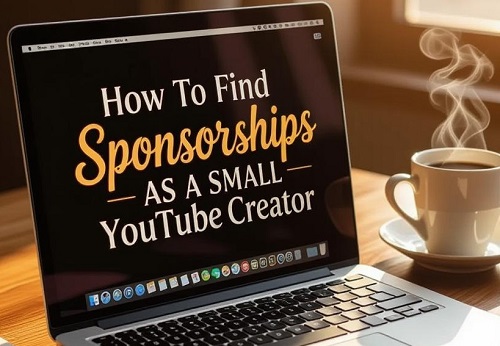How to Find Sponsorships as a Small YouTube Creator
Last Updated: October 2025 | Estimated Reading Time: 20 minutes
Breaking into the world of sponsorships can feel overwhelming when you are a small YouTube creator. The good news is that brands are no longer only targeting massive influencers — micro and niche creators are now highly sought after. This comprehensive guide will show you how to find sponsorships on YouTube, even if you’re just starting out.

Why Brands Work With Small YouTubers
Contrary to popular belief, you don’t need millions of subscribers to land brand deals. Companies are increasingly interested in micro-influencers (10k–100k subscribers) and even nano-influencers (1k–10k subscribers). Why? Because small creators often have:
- Higher engagement rates – Audiences trust smaller creators more than celebrity influencers.
- Strong niche communities – A small but loyal following is often more valuable than a huge but passive one.
- Affordable collaborations – Smaller sponsorship budgets make it easier for brands to experiment.
According to Influencer Marketing Hub, 77% of brands say they prefer working with micro-influencers because of their authenticity and relatability.
Step 1: Strengthen Your Channel Before Reaching Out
Before you send out sponsorship requests, make sure your YouTube channel looks professional and attractive to potential brands. Focus on:
- Optimized Branding – Use consistent visuals like thumbnails, banners, and logos.
- Clear Niche – Brands want to know exactly who your audience is (gaming, beauty, tech, education, etc.).
- Engagement Over Views – Respond to comments, create community polls, and encourage interaction.
Step 2: Build a Media Kit
A media kit acts as your digital resume for sponsorships. It tells brands why they should collaborate with you. Include:
- Channel overview and niche
- Audience demographics (age, gender, location)
- Engagement stats (average views, likes, comments)
- Previous collaborations (if any)
- Your contact details and social links
You can design a free media kit using Canva or similar design tools.
Step 3: Research and Identify the Right Brands
Not every brand is a good fit for your audience. Focus on companies that align with your content style. For example:
- Gaming channel → Gaming accessories, energy drinks, streaming gear
- Beauty channel → Skincare products, makeup brands, wellness apps
- Educational channel → E-learning platforms, productivity tools, book publishers
Use platforms like Grapevine Logic, FameBit (now YouTube BrandConnect), or AspireIQ to connect with brands looking for creators.
Step 4: Craft the Perfect Pitch
Your pitch email is your chance to make a great first impression. Keep it short, professional, and focused on what you can offer the brand. A winning pitch should include:
- Personalized greeting (address the brand or marketing manager by name)
- A quick introduction about your channel
- Why you love their brand and how it aligns with your content
- What you can deliver (e.g., product review, tutorial, integration)
- A call to action (suggest a quick call or request details)
Pro Tip: Don’t focus only on what you’ll get paid. Highlight the value you bring to the brand.
Step 5: Start Small With Affiliate Programs
If you’re new and struggling to land direct sponsorships, affiliate marketing can be a great first step. Many brands run affiliate programs where you earn a commission for sales generated through your link. Examples include:
This helps you build proof that you can drive conversions, which makes you more attractive to sponsors.
Step 6: Network With Other Creators
Networking with fellow YouTubers in your niche can open up opportunities. Join Facebook groups, Discord servers, and online communities where creators share contacts and sponsorship tips. Collaborations can also expose your channel to new audiences, making you more appealing to brands.
Step 7: Deliver Results and Build Long-Term Partnerships
Once you land a sponsorship, your goal should be to over-deliver. Provide detailed performance reports to the brand, showcasing metrics like impressions, engagement, and conversions. This increases the chances of turning a one-off deal into a long-term partnership.
Common Mistakes to Avoid
- Mass emailing the same pitch to dozens of brands.
- Accepting sponsorships from brands unrelated to your niche.
- Over-promoting products and losing authenticity with your audience.
- Ignoring legal requirements like FTC disclosure rules.
Final Thoughts
Finding sponsorships as a small YouTube creator requires persistence, strategy, and professionalism. Focus on growing your community, creating high-quality content, and building authentic relationships with brands. Remember, even small creators can land meaningful sponsorships if they position themselves the right way.
Looking for more tips? Check out our YouTube Monetization Checker to see if your channel is eligible for monetization, and explore our Website SEO Checker to boost your online presence.